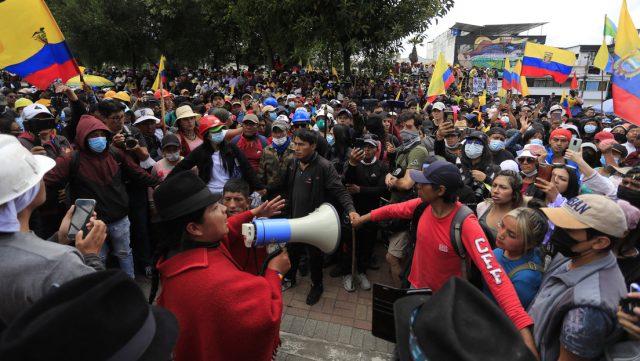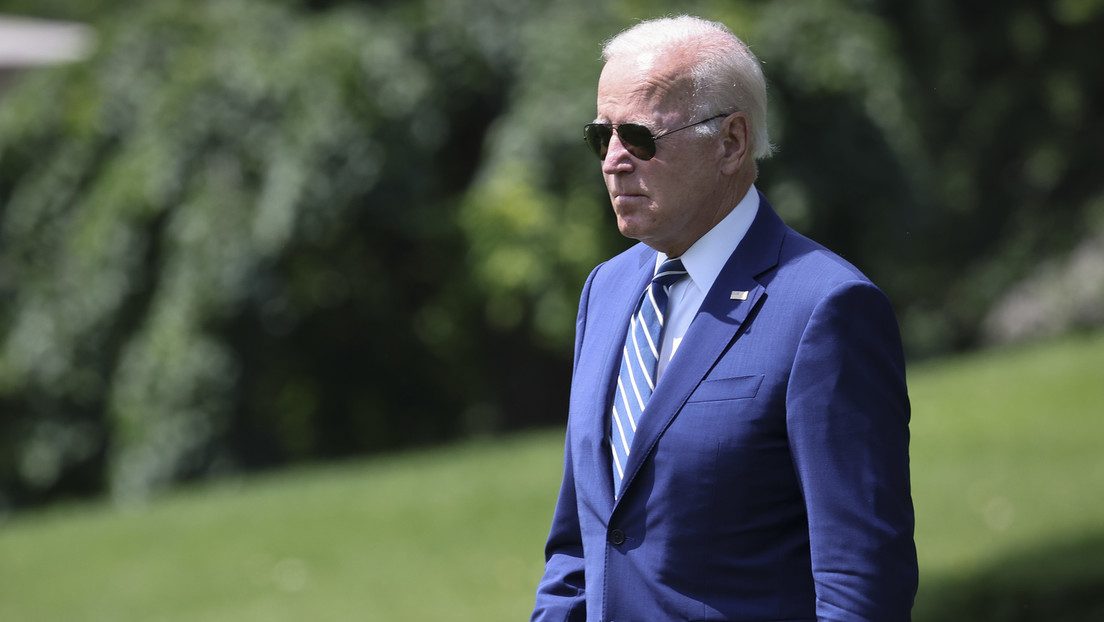On Thursday, June 30, the indigenous movement in Ecuador ended a national strike that they maintained for 18 days throughout the country, although with the largest concentration of people in Quito.
The strike, which was indefinite, began on June 13, after a year of unsuccessful dialogue with the government. From the Confederation of Indigenous Nationalities of Ecuador (Conaie), one of the convening organizations, they indicated that they activated social mobilization due to the «inability and lack of will» of the Executive «to respond to social demands», explains journalist Edgar Romero for RT.
The day the strike began, Conaie, together with the other organizations that called the protests, such as the National Confederation of Peasant, Indigenous and Black Organizations (Fenocin) and the Council of Evangelical Indigenous Peoples and Organizations of Ecuador (Feine), formally handed over, to he Presidency of the country, a petition with 10 demands, which were:
1. Reduction and no more rise in fuel prices.
2. Moratorium and renegotiation of debts with the financial system for more than 4 million families.
3. Fair prices on farm products.
4. Employment and labor rights.
5. Moratorium on the expansion of the extractive mining/oil frontier.
6. Respect for the 21 collective rights.
7. Stop the privatization of strategic sectors.
8. Price control policies and against speculation of basic necessities.
9. Health and education.
10. Policies to curb the wave of violence in Ecuador.
During the time that the demonstrations were taking place, the Government responded to some of these demands and others remained pending to be resolved in a dialogue during the next 90 days, as established in the «Act for Peace» signed by the indigenous organizations and the Executive on Thursday, which gave way to the lifting of the strike.
Fuel price
The «Act for Peace» was signed thanks to the mediation of the Ecuadorian Episcopal Conference (CEE), it summarizes the consensus and commitments that the protesters reached with the Government.
The most relevant point, which is the first in the 10 demands, is the price of fuel. The indigenous movements managed to achieve a reduction of 15 cents on the dollar in the cost of a gallon of diesel and in that of extra and ecopaís gasoline, the most used in Ecuador.
In this way, the price of a gallon of diesel went down from 1.90 to 1.75 dollars and that of extra and ecopaís gasoline from 2.55 to 2.40.
This reduction was done in two parts. First, the country’s president, Guillermo Lasso, announced a drop of 10 cents on the dollar, and established it with the issuance of Executive Decree 462, of June 26, which the indigenous movement classified as «insufficient»; but later it was agreed to add 5 cents of a dollar to the reduction, the decision being fixed in Executive Decree 467, dated June 30.
However, with this agreement, fuel prices were still far from what the dissatisfied initially asked for in their 10-point request. There, they requested the reduction and freezing of the cost of a gallon of diesel at 1.50 dollars and that of extra gasoline and ecopaís at 2.10.
On this request, as an additional measure and as demanded by the indigenous movement, the parties will work on a process to target a subsidy for the sectors that need it most, such as farmers, peasants, transport workers, fishermen, among others.
Hydrocarbons and mining
In addition to the reduction in fuel prices, the indigenous movement achieved, as a response to point five of their demands, that the Government accept the repeal of Decree 95, issued by President Lasso on July 7, 2021, in which the hydrocarbon policy and an ‘Immediate Action Plan’ for the development of the hydrocarbon sector were issued.
The derogation has already been fulfilled. Through the issuance of Executive Decree 466, dated June 29, 2022.
Also, although the protesters called for the repeal, changes were agreed to Decree 151, also signed by Lasso last year, in which the «Action Plan for the Mining Sector» was published. Among the modifications, the exclusion of extractive activity was established in:
* Protected areas and ancestral territories.
* Areas declared as intangible.
* Archaeological zones.
* Water protection areas.
In addition, prior, free and informed consultation will be guaranteed in the communes, communities, peoples and indigenous nationalities, considering the standards dictated by the Inter-American Commission on Human Rights (IACHR) and the Ecuadorian Constitutional Court.
What else did they get for Ecuador?
During the days of the strike, the Government issued other decrees, with which it responded to other points on the agenda presented by the indigenous movement.
Price Control
With Decree 452, of June 15, the governors of all the provinces of the country were ordered to intensify and strengthen the operations and control mechanisms necessary to prevent and eradicate speculative processes, in coordination with the National Police departments; in particular, those that illegally raise prices subject to the official price.
Health Emergency
With Decree 454, of June 17, Lasso ordered the Minister of Public Health, Ximena Garzón, to declare, through a reasoned resolution and in the exercise of her powers, the emergency in the health sector in order to speed up the supply of medicines. and resources necessary to operate the comprehensive public health network.
Compensatory Public Policies
In Decree 456, of June 18, the president established «guidelines for the adoption of compensatory public policies in the face of the increase in the cost of living after the covid-19 pandemic and the international logistics crisis».
There, among other things, it was established to increase the human development bonus from 50 to 55 dollars, which is given to families in conditions of poverty and extreme poverty; double the budget for the Secretariat of Bilingual Intercultural Education and Ethno education; subsidize up to 50% the price of urea for small and medium farmers; that BanEcuador forgive all overdue loans up to 3,000 dollars, that it reduce the interest rate from 10 to 5% for loans of up to 3,000 dollars and that it make available 100 million dollars for credits for small and medium producers.
Additional Agreements and Announcements
In one of his various messages that he gave to the country during the demonstrations, Lasso promised not to privatize public services and strategic sectors.
Likewise, in the «Act for Peace», signed between both parties on Thursday, it was established to prepare a reform bill for article 66 of the Organic Law of the Amazon Special Territorial Circumscription, so that the allocations administered by the Decentralized Autonomous Governments (GAD) become managed by the nationalities and indigenous peoples in their respective jurisdictions.
Dead, wounded and those investigated in Ecuador
During the 18 days of protest, according to the local Alliance of Organizations for Human Rights, which denounced a strong repression by agents of the National Police and the Armed Forces against the protesters, six deaths, 331 injuries and 152 detainees were recorded.
An International Solidarity and Human Rights Mission, which was in Ecuador following up on the protests, issued a preliminary report, in which it concludes that the Ecuadorian State «has committed crimes against humanity».
“In the framework of the national strike and, through its armed and security forces, (the State) would have murdered, tortured, injured physical integrity, persecuted, threatened, intimidated and criminalized important sectors of the civilian population. The criminalization and repression unleashed prevented, limited and conditioned political participation, the right to assembly and the right to protest», says the mission in its document.
The State Attorney General’s Office (FGE) reported on June 28 that it had opened «261 preliminary investigations and 29 prosecution instructions» in the context of the demonstrations. He explained that among the crimes investigated are terrorism, homicide, intimidation, paralysis of a public service, attack or resistance, illicit association, rebellion and torture, among others.
Ecuador’s Losses
The general manager of the Central Bank of Ecuador (BCE), Guillermo Avellán, announced, during the presentation of the results of the national accounts for the first quarter on Thursday, that the economic losses derived from the strike may be above 800 million dollars, surpassing those of the October 2019 protests.
In particular, the Ecuadorian Federation of Exporters (FEDEXPOR) detailed that the non-oil export sector accumulated a loss of 85 million dollars until June 28, 2022.
According to the organization, about 86% of the impact is concentrated in flowers, bananas and broccoli.



